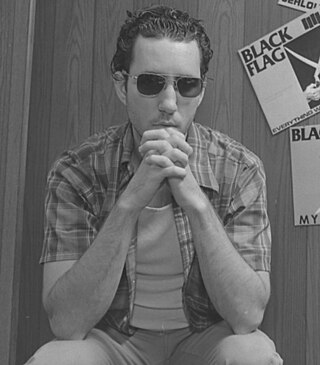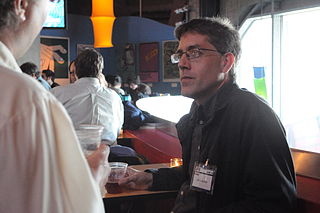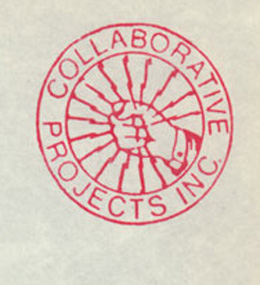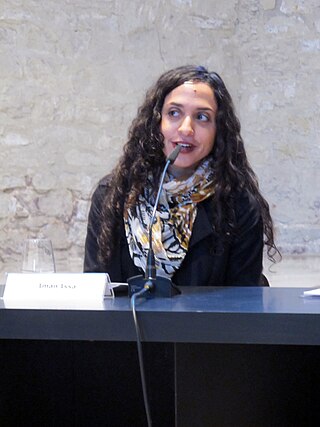Related Research Articles

Raymond Pettibon is an American artist who lives and works in New York City. Pettibon came to prominence in the early 1980s in the southern California punk rock scene, creating posters and album art mainly for groups on SST Records, owned and operated by his older brother, Greg Ginn. He has subsequently become widely recognized in the fine art world for using American iconography variously pulled from literature, art history, philosophy, and religion to politics, sport, and sexuality.

Anthony Schmalz Conrad was an American video artist, experimental filmmaker, musician, composer, sound artist, teacher, and writer. Active in a variety of media since the early 1960s, he was a pioneer of both drone music and structural film. As a musician, he was an important figure in the New York minimalist scene of the early 1960s, during which time he performed as part of the Theatre of Eternal Music. He became recognized as a filmmaker for his 1966 film The Flicker. He performed and collaborated with a wide range of artists over the course of his career.

Wobbly is the moniker of Jonathan Henning Leidecker an American musician/composer of experimental electronic music based in San Francisco.

Jean-Marc Bustamante is a French artist, painter, sculptor and photographer. He is a noted conceptual and installation artist and has incorporated ornamental design and architectural space in his works.

The Barcelona Museum of Contemporary Art is a contemporary art museum situated in the Plaça dels Àngels, in El Raval neighborhood, Ciutat Vella district, in Barcelona, Catalonia, Spain. The museum opened to the public on 28 November 1995.

Colab is the commonly used abbreviation of the New York City artists' group Collaborative Projects, which was formed after a series of open meetings between artists of various disciplines.
Rachel Harrison is an American visual artist known for her sculpture, photography, and drawing. Her work often combines handmade forms with found objects or photographs, bringing art history, politics, and pop culture into dialogue with one another. She has been included in numerous exhibitions in Europe and the US, including the Venice Biennale, the Whitney Biennial and the Tate Triennial (2009). Her work is in the collections of major museums such as The Museum of Modern Art, New York; Metropolitan Museum of Art, New York; Hirshhorn Museum and Sculpture Garden, Washington, D.C.; and Tate Modern, London; among others. She lives and works in New York.

Aspen was a multimedia magazine published on an irregular schedule by Phyllis Johnson from 1965 to 1971. The magazine was based in New York City. Described by its publisher as "the first three-dimensional magazine," each issue came in a customized box or folder filled with materials in a variety of formats, including booklets, "flexidisc" phonograph recordings, posters, postcards and reels of super-8 movie film. Many of the leading figures in contemporary North American and British art and cultural criticism were editors, designers or contributors to Aspen. The magazine has remained of interest to students of the artistic ferment of the late 1960s; extensive documentation of Aspen's contents is available online at UbuWeb.
Jonathan Horowitz is a New York-based artist working in video, sculpture, sound installation, and photography. Horowitz critically examines the cultures of politics, celebrity, cinema, war, and consumerism. From found footage, Horowitz visually and spatially juxtaposes elements from film, television, and the media to reveal connections and breakdowns between these overlapping modes of communication.

Lutz Bacher was an artist closely associated with Berkeley, California since the 1970s, and who lived and worked in New York City from 2013 until her death. The name Lutz Bacher was a pseudonym, and the artist did not publicly reveal a former name. She was once considered a figure with "cult" status—known for being "legendary but elusive" in the California art scene. Since the early 2000s, her work increasingly gained mainstream recognition.

Iman Issa is an Egyptian multi-disciplinary artist whose work looks at the power of display in relation to academic and cultural institutions at large.
Trisha Baga is an American artist living and working in New York City. Her work is installation based and incorporates video, performance, and found objects.

Steffani Jemison is an American artist, writer, and educator. Her videos and multimedia projects explore the relationship between Black embodiment, sound cultures, and vernacular practices to modernism and conceptual art. Her work has been shown at the Museum of Modern Art, Brooklyn Museum, Guggenheim Museum, Whitney Museum, Stedelijk Museum Amsterdam, and other U.S. and international venues. She is based in Brooklyn, New York and is represented by Greene Naftali, New York and Annet Gelink, Amsterdam.
Julie Becker (1972–2016) was an interdisciplinary American artist. She earned her BFA and MFA at CalArts in Los Angeles. Becker earned early acclaim for her 1996 installation Researchers, Residents, A Place to Rest. Her works have appeared at the Whitney Museum of American Art and the Museum of Contemporary Art, Los Angeles and are included in the permanent collections of the Museum of Modern Art (MoMA), the Solomon R. Guggenheim Museum, the Hessel Museum of Art, the Denver Art Museum, and the Migros Museum of Contemporary Art. Her work is represented by Greene Naftali Gallery.

Greene Naftali is a contemporary art gallery located in the Chelsea neighborhood of New York City.
Amber Robles-Gordon is an American mixed media visual artist. She resides in Washington, DC and predominantly works with found objects and textiles to create assemblages, large-scale sculptures, installations and public artwork.
Ramin, Rokni, Hesam are a UAE-based artist collective from Iran, consisting of Ramin Haerizadeh, Rokni Haerizadeh, and Hesam Rahmanian who's working and living together described as a project, since 2009.
Patricia Dauder is a Spanish artist based in Barcelona.

Jacqueline Humphries is a renowned American abstract painter married to Tony Oursler. She is known for her large-scale paintings that reference the history of abstraction, combining traditional painterly techniques with contemporary technologies. She has used metallic silver pigment to suggest the glow of a cinema screen, and has incorporated emoticons, emoji, kaomoji, and CAPTCHA tests into recent works that draw on digital communication. Other paintings are produced by scanning her earlier canvases, translating them into ASCII character code, and using custom laser-cut stencils of the resulting images as the basis for new paintings. Humphries lives and works in New York City, where she is represented by Greene Naftali Gallery.
Kristin Oppenheim is an American artist who lives and works in New York City. She is best known for her installation art based in sound, film, and performance. Oppenheim’s work explores connections between musical rounds, film loops, and choreography. Since the early 1990s, she has been making poetic works that often explore time and memory.
References
- ↑ "UbuWeb Film & Video: Tony Cokes". ubu.com. Retrieved 2020-02-26.
- ↑ Boucher, Brian (2012-12-23). "Tony Cokes". Art in America. Retrieved 2019-08-18.
- ↑ "Tony Cokes | MoMA". The Museum of Modern Art. Retrieved 2019-08-18.
- 1 2 "Word 2 My Mother, Museum of Modern Art, Press Release" (PDF). November 1991.
- ↑ "Wilson, Fo. (active Milwaukee, WI, 2010)". African American Visual Artists Database (AAVAD). 2010-09-17. Archived from the original on 2010-09-17. Retrieved 2022-02-14.
- ↑ "Tony Cokes at Greene Naftali Gallery". www.artforum.com. Retrieved 2019-08-24.
- 1 2 "Tony Cokes - Announcements - e-flux". www.e-flux.com. Retrieved 2019-08-18.
- ↑ Smith, Roberta; Farago, Jason; Schwendener, Martha; Steinhauer, Jillian (2018-05-23). "What to See in New York Art Galleries This Week". The New York Times. ISSN 0362-4331 . Retrieved 2019-08-24.
- 1 2 "Electronic Arts Intermix: Tony Cokes : Biography". www.eai.org. Retrieved 2019-08-18.
- ↑ "Tony Cokes: "Black Celebration (A Rebellion Against the Commodity)" | Hammer Museum". hammer.ucla.edu. 9 June 2019. Retrieved 2021-04-09.
- 1 2 3 Der Kunst, Haus (Dec 11, 2017). "Artist Talk; "Black Celebrations Sound and Vision"". YouTube.
- ↑ Debord, Guy (1970). The Society of the Spectacle. Translated by Perlman, Fredy; Supak, Jon (Revised 1977 ed.). Red & Black.
- ↑ Duplan, Anais (Winter 2019). "Tony Cokes, Black Celebration, 1988, 17 mins. 17 secs". Virginia Quarterly Review. 95 (4) – via Project Muse.
- ↑ "Art in America - Tony Cokes in Conversation with William S. Smith - Recent Press - Greene Naftali". www.greenenaftaligallery.com. Retrieved 2021-04-09.
- 1 2 "Tony Cokes: Selector". www.argosarts.org. Retrieved 2021-04-09.
- ↑ Blair, Elizabeth (October 1, 2024). "Here's who made the 2024 MacArthur Fellows list". NPR. Retrieved 3 October 2024.
- ↑ "*The Tony Cokes Remixes* No. 1". 17 June 2018.
- ↑ "The Tony Cokes Remixes No. 2 - Events - Berlin Biennale".
- ↑ "Goldsmiths CCA — TONY COKES". goldsmithscca.art. Retrieved 2019-08-24.
- ↑ "Greene Naftali Gallery". www.greenenaftaligallery.com. Retrieved 2019-08-24.
- ↑ "Collision/Coalition". The Shed. Retrieved 2019-10-01.
- ↑ "February 2021". Circa.art. Archived from the original on 2021-05-09. Retrieved 2021-04-09.
- ↑ "Tony Cokes. Música, text, política [Reportatge fotogràfic exposició] | MACBA Museum of Contemporary Art of Barcelona". www.macba.cat. Retrieved 2021-04-09.
- ↑ "Tony Cokes: Market of the Senses. Exhibition at the Memorial Art Gallery" . Retrieved 2021-10-25.